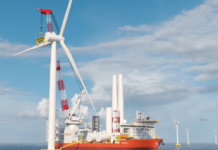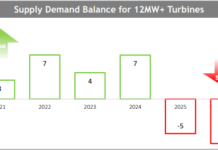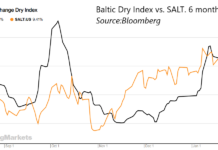by Debra Fiakas
The Lieutenant Governor of New York, Linda Hochul, has predicted that the state will be a world leader in off-shore wind power – a bold assertion for a state that still derives three-quarters of its electric power from fossil fuels. Natural gas has become the most important fossil fuel source. Yet in 2016, for the first time, over one million megawatt hours of electricity were sources from solar power and 24% of electricity is generated by renewable sources. This is remarkable given that just a few years ago even that accomplishment was given very low odds. There appears to be some reasons for confidence in other renewable power sources.
Just a month ago the October 20th post “Firsts for Deepwater Wind” outlined the success of that company in building and operating five wind turbines off the coast of Block Island. Technically Block Island is part of Rhode Island, but the only connection to the mainland is a ferry that runs to Block Island from Montauk on New York’s Long Island. The collective 30 megawatts of power production is sent to the New England power grid. Deepwind has another project underway off the northeastern shore of Long Island that is planned for another 90 megawatts capacity.
Nonetheless, Deepwater Wind is only one, small company. For New York’s leadership to be proven right, many more wind towers will need to sprout up around the state. Statoil, SA (STO: NYSE), the Norwegian energy company, has made large scale wind power projects the cornerstone of its renewable energy strategy. The oil and gas heavy weight is committed to build the Empire Wind project off the eastern shore of Long Beach Island in New York. Straddling just over 79,000 acres, the project will generate one gigawatt of power for New York customers.
With a market capitalization of $66.4 billion, Statoil is a bit out of place in this forum dedicated to small companies. Yet, any discussion of renewable energy has to include the mega-cap oil and gas leaders. Nearly all have made renewable energy investments despite continuing to explore and develop fossil fuel projects. Statoil has made clear the view that a balanced energy mix is its objective. The company recently established its New Energy Solutions Division to execute on the strategy and invested $200 million in the Statoil New Energy Solutions Fund. Guidance is for renewable energy sources to reach 20% of capital spending by 2030. Wind energy is a favorite because Statoil engineers have concluded it is competitive with natural gas without subsidies.
Statoil has plenty of cash to fund capital investments. At the most recent financial report date at the end of September 2017, the Company has $18.6 billion in cash and equivalents. Only about $11 billion in cash is needed for working capital, leaving as much as $7.5 billion in excess cash. There is likely to be more cash at the end of the next quarter. Over the last year Statoil converted to cash 28% out of every sales dollar.
With a company the size of Statoil a few investments in wind power make very little difference. Investors in the company are concerned about the earnings that derive mostly from sales of oil and gas. The stock currently trades at 17.1 times forward earnings. This compares to an average trailing price-earnings multiple of 22.2 times for the oil and gas refinery group.
Statoil appears undervalued against its peers, and even more attractive against its own growth prospects. Analysts have predicted earnings growth in excess of 25% over the next five years. The stock’s Price-Earnings to Growth ratio is just 0.60. The ratio is even more impressive if the forward dividend yield of 4.2% is considered.
A position in an oil and gas company may not be for every investor. Yet if the State of New York is to achieve its goal for clean energy, companies like Statoil are likely to be a central player.
Debra Fiakas is the Managing Director of Crystal Equity Research, an alternative research resource on small capitalization companies in selected industries.
Neither the author of the Small Cap Strategist web log, Crystal Equity Research nor its affiliates have a beneficial interest in the companies mentioned herein.








Nice to see offshore wind starting to happen on the other side of the atlantic. However, 30 MW and another 90 MW is pretty minimal to be a ‘world leader’… Denmark (population 5 million) has over 1 GW of offshore wind in the pipeline with a much larger installed capacity. Germany is also well over 1 GW installed. The UK, the Netherlands and even Sweden all have hundreds of MW offshore. The same projects in New York will be built by the same players as the european projects as they already have their project management and turbine designs completed as well as the facilities to build as cost effective as possible. The players to watch on the supplier side are Siemens-Gamesa and MHI-Vestas. It is worth noting that the wind segment is really consolidating due to the huge cost of building large scale offshore. On the builder side, EDF and E.ON are players that are not state owned. Hope that helps clear up offshore wind a little.